Minimally Invasive Aortic Valve Replacement Recovery Time
Overview
Minimally invasive heart surgery (also chosen keyhole surgery) is when a conventional operation is performed on or within the eye using modest incisions. The surgeon also sometimes uses specialized instruments.
Who Is a Candidate for Minimally Invasive or Robotic Surgery?
There are many ways to reach the heart for surgery. Surgeons at Cleveland Clinic e'er try to use the smallest incision to provide the safest and most successful surgery. Your surgical squad volition carefully compare the advantages and disadvantages of minimally invasive techniques with those of traditional surgery techniques. Your surgeon volition decide the best approach for you based on several factors, including the type or eye disease you have and how astringent it is; your age, medical history and lifestyle; and results of tests washed before surgery.
Traditional Middle Surgery
Traditional centre surgery uses an incision through the centre of your chest, through the chest bone. The incision is about 6 to 8 inches long.
This is the safest and most normally used incision for patients who need complicated heart surgeries, reoperations, multiple coronary avenue bypass procedures or complex aorta procedures.
Types of Minimally Invasive Heart Surgeries
Cleveland Clinic surgeons have performed minimally invasive heart surgery since the mid 1990s. The first surgeries of this type were mitral and aortic valve surgeries. Now, a wide range of procedures can be washed using minimally invasive techniques to help make recovery faster and more comfortable.
Sometimes, minimally invasive surgery includes a partial sternotomy. This involves cutting through office of the breast bone. When possible, the surgeon can avoid cutting the breast os and, instead, make one or more pocket-sized incisions through the muscles betwixt the ribs. This technique is chosen a mini-thoracotomy.
Robotically assisted heart surgery
Most types of robotically assisted heart surgery are used to treat patients with mitral regurgitation (leaky mitral valve). Robotically assisted heart surgery tin can be used for:
- Mitral valve repair
- Tricuspid valve repair (with mitral valve repair)
- Ablation of atrial fibrillation (if other robotic surgery is required)
- Atrial septal defect (ASD) repair
- Patent foramen ovale (PFO) repair
- Removal of cardiac tumors (Myxoma, Fibroelastoma of the mitral or tricuspid valve)
Procedure Details
Types of Incisions Used in Minimally Invasive Heart Surgery
Fractional Sternotomy - through part of the breast bone
A three- to four-inch long incision is made through the sternum, and the chest bone is separated in that area then the surgeon can see the part of the middle that needs surgery.
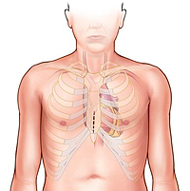
Used for mitral valve, tricuspid valve, epicardial atomic number 82 placement, atrial septal defect (ASD), patent foramen ovale (PFO), myxoma, and aortic valve surgeries.
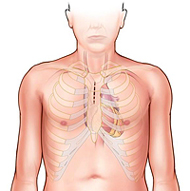
Used for ascending aorta, aortic valve, mitral valve, tricuspid valve, ii valves, transaortic TAVR, ASD, PFO, myxoma and fibroblastoma surgeries.
Mini-thoracotomy
The surgeon avoids cutting through the breastbone and, instead, cuts into muscles between the ribs to accomplish the center.
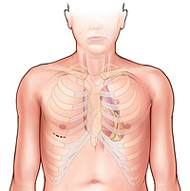
Used for mitral valve, tricuspid valve, ASD, PFO, myxoma surgeries.
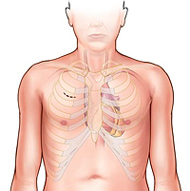
Used for aortic valve, transaortic TAVR and transaortic TEVAR surgeries.
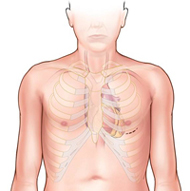
Used for transapical TAVR, transapical TEVAR and epicardial lead placement surgeries.
Robotically assisted center surgery
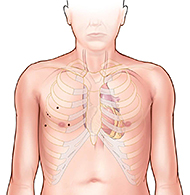
Used for mitral valve, tricuspid valve with mitral, ASD, PFO, atrial myxoma and fibroblastoma surgeries.
Robotically assisted centre surgery is performed through a small working incision and three other small incisions (ports) that are fabricated in the spaces betwixt the ribs. The surgical instruments are attached to the robotic arms. The instruments and a tiny camera are placed through the ports. Movement sensors are fastened to the robotic "wrist," and so the surgeon can control the instruments.
Robotically assisted mitral valve surgery is performed using only the pocket-size port incisions.
Risks / Benefits
Benefits of Minimally Invasive Surgical Techniques
The benefits of minimally invasive surgery include:
- Small incisions
- Small scars
Nigh patients also have
- Less pain
- Shorter infirmary stay after surgery
- Lower take chances of infection
- Lower risk of bleeding and blood transfusion
- Shorter recovery time and faster return to normal activities/work
Recovery and Outlook
Recovery
If you lot take minimally invasive or robotic surgery, yous will probably exist able to go abode 2 to 5 days after surgery. Your healthcare team volition follow you closely while y'all are in the hospital and help yous recover equally quickly as possible. When you are ready to leave the hospital, you will get instructions on your recovery and return to work, including guidelines for action, driving, incision intendance and nutrition.
In general, it takes well-nigh i to 4 weeks before yous will experience well enough to return to work (if your job doesn't involve concrete activity), resume driving and take role in well-nigh nonstrenuous activities, so long as y'all accept stopped taking pain medications. You can usually get entirely back to your normal routine in five to 8 weeks after surgery. It is important to know that everyone has a different recovery and your healthcare squad will give you guidelines based on how well y'all are doing.
Good for you Living
To go on your heart healthy after surgery, information technology is important to make lifestyle changes and have your medications equally prescribed. Heart-healthy lifestyle changes that are of import to your recovery include:
- Quitting smoking
- Controlling high cholesterol
- Managing high blood force per unit area and diabetes
- Exercising regularly
- Maintaining a healthy weight
- Eating a heart-good for you diet
- Taking role in a cardiac rehabilitation program, equally recommended
- Post-obit up with your doctor for regular visits
eriksoncatelleaden.blogspot.com
Source: https://my.clevelandclinic.org/health/treatments/17233-minimally-invasive-heart-surgery

0 Response to "Minimally Invasive Aortic Valve Replacement Recovery Time"
Post a Comment